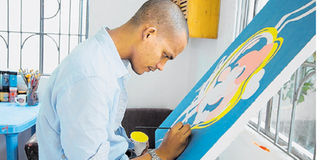Kejo’s surreal depictions of life bring out flat optimism and joy

The topics as potrayed by Ibrahim Kejo are as broad and all-encompassing as the human experience. These include, love, war, power, vulnerability, happiness, stereotypes and other physical and emotional experiences. PHOTO | COURTESY
What you need to know:
- The theme “Welcome to Heartbreak” itself referred to Kejo exposing his heartbreak experience in the form of paintings which he viewed as love letters which he couldn’t send. He refers to this situation by a name he coined, ‘veegerism’.
- “The experience was completely a shock to me,” he would say adding, “I had never been in a situation where my work was the centre of attention with people knowing the artist behind the work.”
When he held his first art exhibition on January 15, 2013 under the theme “Welcome to Heartbreak”, Ibrahim Kejo, 30, never thought that his works would be well received.
The theme “Welcome to Heartbreak” itself referred to Kejo exposing his heartbreak experience in the form of paintings which he viewed as love letters which he couldn’t send. He refers to this situation by a name he coined, ‘veegerism’.
“The experience was completely a shock to me,” he would say adding, “I had never been in a situation where my work was the centre of attention with people knowing the artist behind the work.”
Ibrahim Kejo is a Norwegian-Tanzanian artist whose works are covertly admired in Tanzania. He has designed for the largest brands as well as an alluring 70 metre mural that calls the State House home. Kejo’s paintings are in private collections of art fans all over the world.
Kejo studied at International School of Tanganyika for his primary, secondary education up to high school where he graduated in 2005.
After that he went to Norway to take a year off from studies before proceeding to art school in the same country which he preferred not to mention, “but dropped out in second year because I felt I was being taught things that I already knew or had no interest in learning like building art installations from recycled items,” says the 29-year-old Kejo.
It was during this time that Kejo says he started to think seriously about art, more specifically, painting, as a career of choice and, “I would have to make my own set of rules and discover my own style instead of following what everybody else was doing.”
Kejo says he has always been drawing and practicing art ever since he could hold a pencil. He started to take the hobby a bit more seriously a few years ago whilst he was working as a graphic designer.
Whilst the graphic design work he was doing was creative, his creativity was restricted and limited to what the clients wanted.
“So painting was a good outlet for my creativity as I would not take any creative direction from anybody.”
Sitting in a beautiful safari chair, in his black and red chess board, long sleeves shirt with gray khaki trouser, a tall and slim Kejo seems to be proud of his family which he says is blessed with immense creative people including poets, opera singers, musicians, linguists and painters.
“This has enabled me to have a strong support base and inspiration from a very young age.”
In terms of painters, Kejo is inspired by Salvador Dali, Francis Bacon, Gustav Klimt and Sebastian Krüger.
Kejo’s art is at first glance colourful and bright giving off a sense of cartoon-like cheerfulness and flat optimism.
The underlying themes of the works are the human experience in all its’ ups, downs, and in-betweens, albeit with a touch of somewhat dark humour and irony.
The way this is shown is through what the artist likes to call ‘psychological portraits’, as the works are surreal depictions of the various psychological landscapes of people as they meander through the human experience.
A common trait of the work is fragmented faces, which can be seen as deconstructing the person to get a more honest depiction of their psychological state.
Most of his paintings are accompanied with titles which play an integral part in understanding the work and can even be seen as an extension of the artwork as they serve as a guide to the artist’s thinking in each piece.
The topics are as broad and all-encompassing as the human experience. These include, love, war, power, vulnerability, happiness, stereotypes and other physical, psychological and emotional experiences.
Kejo held his second exhibition in 2014 whose theme he says was a continuation of the first theme, under the theme “Dear Mr Heartbreak”, but the work became a lot darker and sarcastic.
The work had also evolved but there were still elements that continued from the first show which were abstract shapes, bright colours, and a tinted monocle with its chain wrapping itself around various elements in the painting,” he says.
Kejo held his third exhibition this year from 29 March-8 April which took place at the Alliance Française under the theme An “Accidental Coronation”.
An Accidental Coronation is a selection of new paintings compiled over a three-year hiatus from the arts scene which according to Kejo had a positive response from the public.
“There was more awareness towards the exhibition and I feel people are a bit more open-minded about what art is as opposed to a few years ago,” says Kejo who is the last born in a family of two.
Kejo terms his art as Pop Surrealism which is a blend of Pop which feature the use of bright colours; Surrealism in the subject - for example, the melting face of a person behind a floating glass and caricature art by the exaggerated portraits of people who are the dominant part of his paintings.
Inspiration plays a huge part in making Kejo’s paintings successful. He could be at home preparing ingredients for a meal when inspiration hits out of nowhere and he would have to make a quick sketch or take notes of a word(s) which would serve as an important element in the painting, either an object to include in the painting or a word to include in the title.
“I would then take my draft/notes and create the base sketch of the painting and depending on whether or not I feel like it at that moment, I would then proceed onto what I think is one of the more difficult aspects of my work - deciding on what colour to use and to mix various colours to get that exact colour I’m thinking of.”
His paintings can take anywhere from 6 hours to 3 weeks.
The ability to have total and complete freedom in the way he can express himself without there being a right or wrong way to do a painting is what Kejo likes most of his painting career.
“If I want to paint someone with a green face and purple hair, I am free to do so,” he says.
Email: [email protected]




